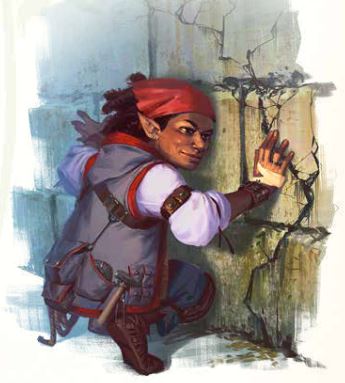
Wizards know how it is. Sometimes you go a little far with your designs and create a trap that’s dangerous and unpredictable—but useful! (This is part 3 of 3! See the first Traps a Mad Wizard Must Have Designed here.)
Venturing into a long-abandoned ruin, adventurers expect deliberate traps and safeguards. However, the ravages of time can create unintended dangers that wind up acting a lot like traps! These three traps are inspired by locations that maybe weren’t intended to punish would-be treasure seekers, but they could still cause adventurers to find their final resting place.
The traps described here are loosely based on scenes from famous TV shows and movies. Some details have been left vague to make them easier to add to your existing campaign.
Like tricky things? Check out the Labyrinth Worldbook Kickstarter campaign!
Visit the world between worlds, connecting every fantasy game you can imagine. Sign up to get notified!
Last Stand
Trap
A massive, vaulted chamber was clearly the site of a brutal fight-turned-massacre some time in the distant past. Armored skeletons and scattered weapons litter the floor.
The interior is 100 x 80 feet, with a half-dozen blocky stone columns interspersed through the space. Several cairns are erected for the leaders of the fallen.
Trigger: Any creature moving across the floor must make a successful DC 15 DEX (Stealth) check to avoid disturbing the remains. Repeat this check every minute a creature remains in the room. Items of value rest against or under skeletons, on precarious weapon rack, or crumbling cairns. Attempts to study or retrieve the items require another DEX Stealth check. And failure triggers the trap.
Effects: A failed DEX (Stealth) check causes a dramatic noise that echoes through the chamber and out into the corridors beyond. One round after the failed check, loud drums echo in the distance as creatures alert to the noise signal the presence of intruders. The PCs have an additional 1d4 rounds to escape the chamber before monstrous inhabitants descend on their position and initiate a new fight in the old place.
Resolution: Avoiding the chamber floor is one way to avoid attracting trouble. Flight, levitation, or a silence spell can all circumvent danger. On a failed roll, the GM might allow a DC 15 DEX check to catch a skeleton, piece of armor, etc., before it crumbles or falls.
Ship on a Rock
Trap [Mechanical]
An ancient sailing ship balances precariously on a tall, rocky pinnacle. It can be reached via surrounding trees or by stepping onto it from a higher cliff nearby. The vessel was left behind by sea level change or deposited there by a storm or the reach of some giant monster. Whatever the cause, this ship has only remained in place because it has been undisturbed. Any movement on board risks causing it to tip forward or back and crash to the distant ground.
Trigger: The moment any creature steps onto the vessel, it begins to sway. The danger is apparent. Locating the fulcrum balancing the ship is a DC 12 INT check.
Effects: Every creature on board must find their balance with a successful DC 12 DEX (Acrobatics) check. On a failure, the creature falls prone and slides 10 feet either fore or aft (away from the fulcrum), as the vessel slowly tilts in that direction with an agonizing creak.
Resolution: The PCs can position themselves on opposite sides of the fulcrum to balance the ship and use items like supply barrels and rusted cannons to offset weight. An attempt to do so is dependent on either speed or quick thinking, calling for a successful DC 12 ability check, using abilities and skills as appropriate to the idea, as called for by the GM.
As the PCs traverse the ship or move anything heavier than 20 pounds, additional DEX (Acrobatics) checks become necessary. For each instance where at least one creature fails a check, increase the DC for subsequent rolls by 1 to reflect the increasingly precarious state of the ship.
Creatures inside the ship don’t fall over the edge. A creature on deck who slides over the edge must make a successful DC 12 DEX save to grab on before the plummet. Going over the side of the ship results in a 60-foot drop, dealing 6d6 bludgeoning damage. At the Gm’s discretion, a sailing ship falling on a victim might deal significantly more damage.
The ship can be stabilized with about an hour of work and 200 feet of rope to tie it to more secure surfaces.
Waste Compactor
Trap [Mechanical]
A small, square hatch leads to a long chute, with the bottom shrouded in darkness. The chute is a steep, diagonal 60-foot drop into what appears to be a 20-foot x 20-foot square stone room. The walls are sheer and flat; the room is filled with debris and gunk built up over decades or even centuries. It is, in fact, a complex trash compactor that is still operational.
Trigger: When a creature slides down the chute and lands on the floor, it activates the trap.
Effects: One round after entering the compactor area, the interior begins to rumble, and the 20-foot walls slowly grind together, closing 5 feet per round on initiative count 1. At the end of 4 rounds, the two walls meet; any creature inside the compactor suffers 10d10 bludgeoning damage.
Resolution: A creature searching the floor’s debris and gunk for an escape can find a small iron maintenance panel at the rear of the compactor with a successful DC 15 WIS (Perception) check. The panel is rusted shut from disuse but can be forced open with a successful DC 15 STR (Athletics) check. Behind is a narrow service tunnel leading out of the compactor. Creatures stuck inside can search the debris. On a successful DC 10 INT (Investigation) check, they can find a thick, iron rod they can use to brace between the two walls. Placing it between the walls delays the crushing walls for 1 round. With some magical means to gain elevation or a successful DC 20 STR (Athletics) or DEX (Acrobatics) check, a creature can scramble up the walls the walls to reach the bottom of the chute and attempt to climb out.
If the walls deal crushing damage, they pause briefly before the mechanism cycles open again.
Read more at this site
